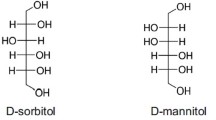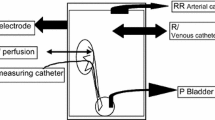Summary
We inhibited the prostaglandin synthesis with indomethacin in rats during a 7-h (periods: 1–4 h; 4–5.5 h; 5.5–7 h) gastroenteric and parenteral infusion of isotonic saline. Indomethacin was given in a dosis of 10 mg/kg of b. wt. by stomach tube after 5.5-h infusion of saline. We studied how far prostaglandins are involved in the different function of the kidney by measuring the water and sodium excretion and the cortico-medullary osmotic and albumin concentrations of the kidney.
-
1.a)
Studies Without Indomethacin. As compared to infusion of isotonic saline into the stomach water excretion is decreased by 30% (P<0.02) and 35% (P=n.s.) in the second and third 90 min period during parenteral infusion of saline. As compared to gastroenteric infusion we found an increase of the total osmolarity by 13% (P<0.02) in the cortex of the kidney.
-
b)
Studies with Indomethacin. As compared to saline infusion into the stomach indomethcin-treated rats decrease their urinary flow rates in 90 min by 26% (P=n.s.) in the presence of equivalent saline infusion into the aorta. Total osmolarity of the parenteral loaded rats increases by 17% (P<0.01) in the cortex of the kidney.
-
2.
Indomethacin leads to an increased concentrating ability of the kidney in both gastroenteric and parenteral loaded rats.
-
3.
In the presence of indomethacin plasma albumin of the kidney increases in the cortex and in the outer medulla of the kidney. In the inner medulla, and in the papillary tip, however, albumin concentration decreases significantly.
As compared to gastroenteric saline infusion, the osmolarity of the kidney tissue increases and the urinary flow rate decreases during equivalent parenteral infusion of isotonic saline. The prostaglandins are not responsible for the pronounced diuresis during infusion of isotonic saline into the stomach.
Zusammenfassung
Bei gastroenteral und parenteral über 3 Urinsammelperioden von insgesamt 7 h (1–4 h; 4–5 1/2 h; 5 1/2–7 h) mit isotoner Kochsalzlösung belasteten Ratten wurde die Prostaglandinsynthese nach 5 1/2 h Infusion mit Indometazin gehemmt.
Es wurde der Effekt oral applizierten Indometazins in einer Dosis von 10 mg/kg KG auf die Wasser- und Natriumexkretion sowie auf die Osmolarität und Albuminkonzentrationen der Niere untersucht.
-
1. a)
Studien ohne Indometazin. Bei Kochsalzinfusion in die Aorta wird nach einem 4stündigen Zeitintervall in der zweiten Periode innerhalb von 90 min 30% (P<0,02) und in der dritten 90-min-Periode 35% (P=n.s.) weniger Wasser eliminiert als bei äquimolarer Salz/Volumenapplikation in den Magen. Die Gesamtosmolarität in der Nierenrinde liegt nach 7 1/2stündiger Kochsalzinfusion in die Aorta 13% (P<0,02) höher als bei gastroenteraler Belastung.
-
b)
Studien mit Indometazin. Unter Indometazin wird während fortgesetzter isotoner Salzinfusion in die Aorta innerhalb von 90 min 26% (P=n.s.) weniger Wasser ausgeschieden als bei gastroenteraler Zufuhr. Die Gesamtosmolarität liegt in der Nierenrinde 17% (P<0,01) höher als bei äquimolarer Infusion in den Magen.
-
2.
Indometazin bewirkt sowohl bei gastroenteraler wie auch bei parenteraler isotoner NaCl-Infusion eine signifikante Zunahme der Gesamtosmolarität in den einzelnen Markregionen.
-
3.
Die Albuminkonzentrationen steigen unter Indometazin in der Nierenrinde und im äußeren Mark an, im inneren Mark und in der Papillenspitze fallen sie dagegen signifikant ab.
Die Befunde zeigen, daß die Nierengewebsosmolaritäten bei akuter parenteraler Salz/Volumenbelastung höher und die Harnvolumina niedriger sind als bei äquimolarer gastroenteraler Applikation. Die Prostaglandine sind nicht für die stärkere Diurese bei isotoner Kochsalzinfusion in den Magen verantwortlich.
Similar content being viewed by others
Literatur
Adlersberg D (1934) Zur Rolle der Leber im Wasserhaushalt. Klin Wochenschr 13:193
Beilin LJ, Bhattacharya J (1977) The effects of prostaglandin synthesis inhibitors on renal blood flow distribution in conscious rabbits. J Physiol 269:395–405
Berl P, Raz A, Wald H, Horowitz J, Czaczkes W (1977) Prostaglandin synthesis inhibition and the action of vasopressin: studies in man and rat. Am J Physiol 232:F529
Combier P, Godon JP (1979) Production of a natriuretic hormone by isolated rat kidneys: necessity of prostaglandins for its release. Kidney Int 16:655 (abstr)
Daly JJ, Roe JW, Horrocks P (1967) A comparison of sodium excretion following the infusion of saline into systemic and portal veins in the dog: evidence for a hepatic role in the control of sodium excretion. Clin Sci 33:481
DeWardener HE, Mills IH, Clapham WF, Hayter CJ (1961) Studies on the efferent mechanism of the sodium diuresis which follows the administration of intravenous saline in the dog. Clin Sci 21:249
Düsing R, Opitz WD, Kramer HJ (1977) The role of prostaglandins in the natriuresis of acutely salt-loaded rats. Nephron 18:212
Düsing R, Melder B, Kramer HJ (1977) Effects of prostaglandin inhibition on intrarenal hemodynamics in acutely saline-loaded rats. Circ Res 41:287–291
Franke H, Niesel W, Röskenbleck H (1970) Differenzierung der Konzentrierungsprozesse des äußeren und des inneren Marks durch Ermittlung der Konzentrationsprofile von Natrium, Kalium und Harnstoff bei unterschiedlichen Funktionszuständen. Pflügers Arch 315:321
Frey E (1906) Der Mechanismus der Salz- und Wasserdiurese. Pflügers Arch Ges Physiol 112:71
Ganguli M, Tobian L, Azar S, O'Donnell M (1977) Evidence that prostaglandin synthesis inhibitors increase the concentration of sodium and chloride in rat renal medulla. Circ Res (Suppl 1) 40:135
Ginsberg W (1912) Diureseversuche. Naunyn-Schmiedebergs Arch Pharmacol 69:381
Grantham JJ, Orloff J (1968) Effect of prostaglandin E1 on the permeability response of the isolated collecting tubule to vasopressin adenosine 3′,5′-monophosphate, and theophylline. J Clin Invest 47:1154
Haberich FJ, Aziz O, Nowacki PE (1965) Über einen osmoreceptorisch tätigen Mechanismus in der Leber. Pflügers Arch 285:73
Heuer LJ (1972) Eiweiß-Konzentrationsprofile im Nierenmark der Ratte während hypertoner Harnstoff- und Kochsalzinfusion. Res Exp Med 158:171
Heuer LJ, Osten H (1974) Der Effekt von Furosemid und hypertonem Mannit auf den corticomedullären Albumingradienten der Rattenniere. Res Exp Med 162:125
Heuer LJ (1978) Untersuchungen über renale Angriffspunkte diuretischer Wirkstoffe in Harnextrakten. Arzneim Forsch Drug Res 28:2152
Itskovitz HD, Terragno NA, McGiff JC (1974) Effect of a renal prostaglandin on distribution of blood flow in the isolated canine kidney. Circ Res 34:770
Kramer K, Thurau K, Deetjen P (1960) Hämodynamik des Nierenmarks. I. Mitteilung. Capilläre Passagezeit, Blutvolumen, Durchblutung, Gewebehämatokrit und O2-Verbrauch des Nierenmarks in situ. Pflügers Arch 270:251
Kömpf B, Karsunky KP, Taugner R (1960) Die Verteilung von J131-Albumin in der Niere von Ratten und Kaninchen. Pflügers Arch 270:251
Kriz W, Lever AF (1969) Renal countercurrent mechanisms: structure and function. Am Heart J 78:101
Lennane RJ, Peart WS, Carey RM, Shaw J (1975) A comparison of natriuretis after oral and intravenous sodium loading in sodium-depleted rabbits: evidence for a gastrointestinal or portal monitor of sodium intake. Clin Sci Mol Med 49:433
Levinsky NG, Lalone RC (1963) The mechanism of sodium diuresis after saline infusion in the dog. J Clin Invest 42:1261
Lydtin H (1969) Untersuchungen über Mechanismen der Osmo- und Volumenregulation. II. Untersuchungen über den Einfluß intravenös, intraportal und oral zugeführter hypotoner Kochsalzlösungen auf die Diurese des Hundes. Z Ges Exp Med 149:193–210
Milies E (1960) A new diuretic factor of hepatic origin. Acta Physiol Lat Am 10:179
Moffat DB (1969) Extravascular protein in the renal medulla. Quart J Exp Physiol 54:60
Mutt V, Said SI (1974) Structure of the porcine vasoactive intestinal octacosapeptide. The amino-acid sequence. Use of kallikrein in its determination. Eur J Biochem 42:581
Newcombe DS, Thanassi NM, Cioser CP (1974) Cartilage cyclic nucleotide phosphodiesterase: inhibition by anti-inflammatory agents. Life Sci 14:505
Sellers AL, Griggs N, Marmorston J, Goodman H (1954) Filtration and reabsorption of protein by the kidney. J Exp Med 100:1
Shorr E, Mazur A, Baez S (1955) Chemical and biological properties of the hepatorenal factors VEM and VDM (Ferritin). Recent Prog Horm Res 11:453
Strelow D, Niesel W, Röskenbleck H (1968) Die Harnstoff- und Elektrolytkonzentrationen im Nierenmarkgewebe nach zweitägiger Infusion hypertoner Harnstoff- und NaCl-Lösungen. Pflügers Arch 301:270
Terragno NA, Terragno DA, McGiff JC (1977) Contribution of prostaglandins to the renal circulation in conscious, anesthetized, and laparotomized dogs. Circ Res 40:590
Thompson WH (1900) Diuretic effects of sodium chloride solutions. J Physiol (Lond) 25:487
Thurau K, Deetjen P, Kramer K (1960) Hämodynamik des Nierenmarks. II. Mitteilung. Wasserdiurese und osmotische Diurese. Pflügers Arch 270:270
Wilde WS, Thurau K, Schnerman J, Prchal K (1963/64) Counter-current multiplier for albumin in renal papilla. Pflügers Arch 278:43
Wilde WS, Vorburger Ch (1967) Albumin multiplier in kidney vasa recta analysed by microspectrophotometry of T-1824. Am J Physiol 213:1233
Wilde WS, Hill JH, Wilson E, Schielke GP (1971) Exchange of free and albumin-bound evans blue in interstitium of hamster kidney. Am J Physiol 220:1991
Zusman RM, Keiser HR, Handler JS (1977) Vasopressin-stimulated prostaglandin E biosynthesis in the toad urinary bladder. J Clin Invest 60:1339
Author information
Authors and Affiliations
Rights and permissions
About this article
Cite this article
Heuer, L.J., Knue-Beestermüller, E. Vergleichende Untersuchungen zur Wirkung gastroenteraler und parenteraler Kochsalzinfusionen auf die Nierenfunktion nach Hemmung der Prostaglandinsynthese. Res. Exp. Med. 178, 43–54 (1980). https://doi.org/10.1007/BF01856757
Received:
Accepted:
Issue Date:
DOI: https://doi.org/10.1007/BF01856757




